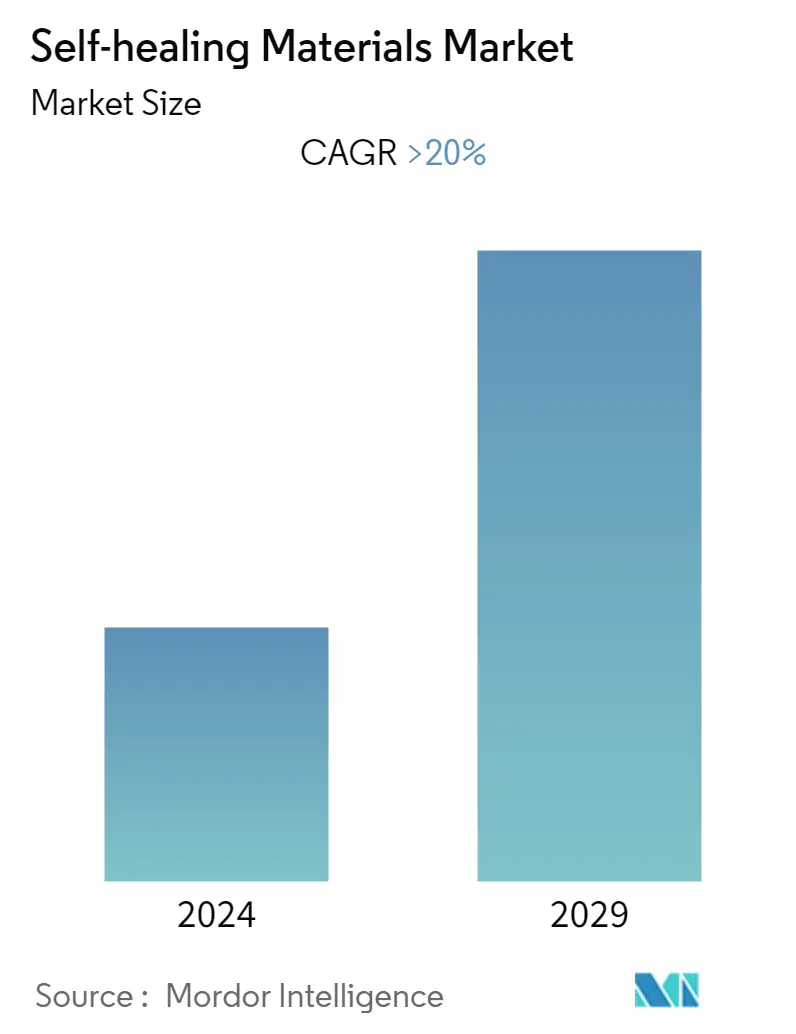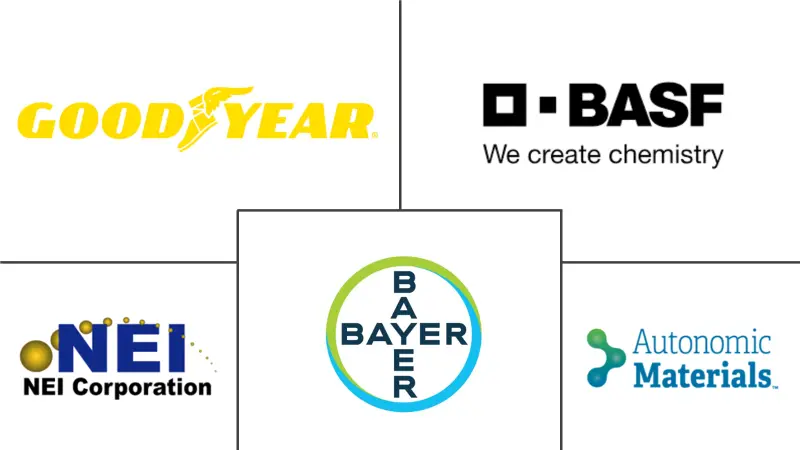Market Size of Self-healing Materials Industry

| Study Period | 2019 - 2029 |
| Base Year For Estimation | 2023 |
| Forecast Data Period | 2024 - 2029 |
| CAGR | 20.00 % |
| Fastest Growing Market | Asia Pacific |
| Largest Market | North America |
Major Players
*Disclaimer: Major Players sorted in no particular order |
Self-Healing Materials Market Analysis
The self-healing materials market is expected to register with a CAGR greater than 20% during the forecast period.
COVID-19 had a significant impact on the logistics and manufacturing industries, thus hampering the market growth. However, the industry started to recover, and from that onwards, the market is driven by steady expansion in the automotive, construction, and aerospace industries.
- The increased development in the construction industry in emerging countries is one of the primary factors driving the market. The growing use of self-healing materials in biomimetics for the healthcare industry is also likely to propel the market.
- However, the high cost of self-healing materials as compared to conventional materials is hindering the growth of the market studied.
- The increasing adoption of self-healing materials in the automobile and electronics industry on the back of rising awareness is likely to act as an opportunity for the market studied.
- Asia-Pacific is expected to witness the highest growth rate during the forecast period.
Self-Healing Materials Industry Segmentation
Self-healing materials are artificial or synthetically manufactured substances that can mend autonomously without needing external diagnostics or human intervention. The self-healing materials market is segmented by type, end-user industry, and geography. By type, the market is segmented into polymers, composites, ceramics, concrete, and other types. The market is segmented into healthcare, automotive, electrical and electronics, construction, aerospace, and other end-user industries by end-user industry. The report also covers the market size and forecasts for self-healing materials in 15 countries across major regions. The market sizing and forecasts are based on each segment's value (USD million).
| Type | |
| Polymers | |
| Composites | |
| Ceramics | |
| Concrete | |
| Other Types |
| End-user Industry | |
| Healthcare | |
| Automotive | |
| Electrical and Electronics | |
| Construction | |
| Aerospace | |
| Other End-user Industries |
| Geography | ||||||||
| ||||||||
| ||||||||
| ||||||||
| ||||||||
|
Self-healing Materials Market Size Summary
The self-healing materials market is poised for significant growth, driven by expanding applications in the automotive, construction, and aerospace sectors. Despite initial setbacks due to COVID-19, the market has shown resilience and is now benefiting from increased construction activities in emerging economies and the growing use of these materials in biomimetics within the healthcare industry. However, the high cost of self-healing materials compared to traditional options remains a challenge. The automotive and electronics industries are increasingly adopting these materials, presenting new opportunities for market expansion. The Asia-Pacific region, particularly China and India, is expected to experience the highest growth rate, fueled by robust construction and industrial activities.
Self-healing materials are becoming integral to the construction industry, offering rapid repair capabilities that enhance the durability and lifespan of structures. This demand is further bolstered by global construction trends and the emphasis on sustainability and high-efficiency buildings. In regions like Asia-Pacific, the demand is skyrocketing due to the materials' superior performance attributes. The market is moderately consolidated, with key players like Autonomic Materials, Inc., BASF SE, and Bayer AG holding significant shares. Recent advancements, such as the development of self-healing polymers and composites, are set to further propel the market, extending the lifespan of critical components in various industries.
Self-healing Materials Market Size - Table of Contents
-
1. MARKET DYNAMICS
-
1.1 Drivers
-
1.1.1 Increased Development in the Construction Industry
-
1.1.2 Growing Use of Self-healing Materials in Biomimetics
-
1.1.3 Other Drivers
-
-
1.2 Restraints
-
1.2.1 High Cost of Self-healing Materials
-
1.2.2 Other Restraints
-
-
1.3 Industry Value-chain Analysis
-
1.4 Porter's Five Forces Analysis
-
1.4.1 Bargaining Power of Suppliers
-
1.4.2 Bargaining Power of Consumers
-
1.4.3 Threat of New Entrants
-
1.4.4 Threat of Substitute Products and Services
-
1.4.5 Degree of Competition
-
-
-
2. MARKET SEGMENTATION (Market Size in Value)
-
2.1 Type
-
2.1.1 Polymers
-
2.1.2 Composites
-
2.1.3 Ceramics
-
2.1.4 Concrete
-
2.1.5 Other Types
-
-
2.2 End-user Industry
-
2.2.1 Healthcare
-
2.2.2 Automotive
-
2.2.3 Electrical and Electronics
-
2.2.4 Construction
-
2.2.5 Aerospace
-
2.2.6 Other End-user Industries
-
-
2.3 Geography
-
2.3.1 Asia-Pacific
-
2.3.1.1 China
-
2.3.1.2 India
-
2.3.1.3 Japan
-
2.3.1.4 South Korea
-
2.3.1.5 ASEAN Countries
-
2.3.1.6 Rest of Asia-Pacific
-
-
2.3.2 North America
-
2.3.2.1 United States
-
2.3.2.2 Canada
-
2.3.2.3 Mexico
-
-
2.3.3 Europe
-
2.3.3.1 Germany
-
2.3.3.2 United Kingdom
-
2.3.3.3 Italy
-
2.3.3.4 France
-
2.3.3.5 Rest of Europe
-
-
2.3.4 South America
-
2.3.4.1 Brazil
-
2.3.4.2 Argentina
-
2.3.4.3 Rest of South America
-
-
2.3.5 Middle-East and Africa
-
2.3.5.1 Saudi Arabia
-
2.3.5.2 South Africa
-
2.3.5.3 Rest of Middle-East and Africa
-
-
-
Self-healing Materials Market Size FAQs
What is the current Self-healing Materials Market size?
The Self-healing Materials Market is projected to register a CAGR of greater than 20% during the forecast period (2024-2029)
Who are the key players in Self-healing Materials Market?
Autonomic Materials, Inc., NEI Corporation., BASF SE, Bayer AG and The Goodyear Tire and Rubber Company are the major companies operating in the Self-healing Materials Market.

